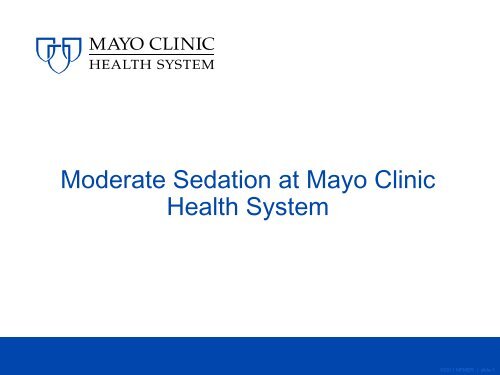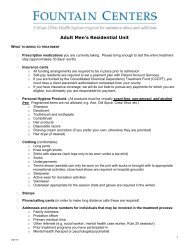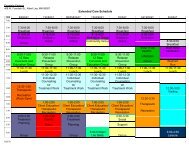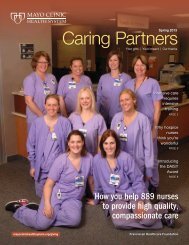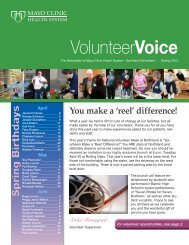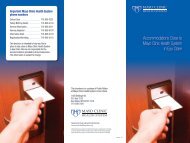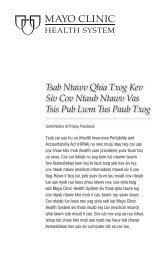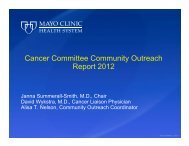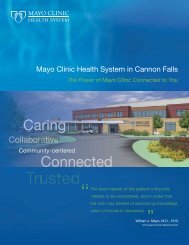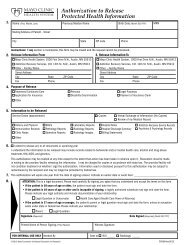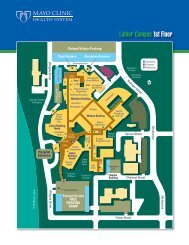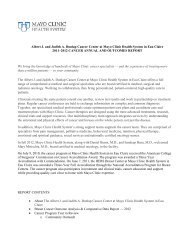Moderate Sedation Presentation - Mayo Clinic Health System
Moderate Sedation Presentation - Mayo Clinic Health System
Moderate Sedation Presentation - Mayo Clinic Health System
Create successful ePaper yourself
Turn your PDF publications into a flip-book with our unique Google optimized e-Paper software.
<strong>Moderate</strong> <strong>Sedation</strong> at <strong>Mayo</strong> <strong>Clinic</strong><br />
<strong>Health</strong> <strong>System</strong><br />
©2011 MFMER | slide-1
Objectives<br />
• Identify general principles and precautions in medications<br />
used for moderate sedation<br />
• Identify components of Administrative Policy 335: <strong>Sedation</strong><br />
and Analgesia for Diagnostic, Therapeutic and Invasive<br />
Procedures<br />
• Identify discharge and transfer criteria used by the <strong>Mayo</strong><br />
<strong>Clinic</strong> <strong>Health</strong> <strong>System</strong> in procedure areas following<br />
moderate or deep sedation<br />
• Define the physician/provider’s responsibilities for preprocedural<br />
assessment in procedures requiring sedation<br />
©2011 MFMER | slide-2
Administrative Policy 335<br />
• A multidisciplinary <strong>Moderate</strong> <strong>Sedation</strong> committee set<br />
policy for all <strong>Mayo</strong> <strong>Clinic</strong> <strong>Health</strong> <strong>System</strong> areas where<br />
moderate sedation is performed by nonanesthesiology<br />
staff<br />
©2011 MFMER | slide-3
<strong>Moderate</strong> <strong>Sedation</strong> Committee Members<br />
• Providers<br />
• Dr. Garber, physician<br />
champion, Emergency<br />
Department<br />
• Dr. Beuning, Emergency<br />
Department<br />
• Dr. Cochrane, Anesthesia<br />
• Theresa Brunetto, Trauma<br />
Services<br />
• Pharmacy<br />
• Paul Finn, Pharm.D.<br />
• Education<br />
• Jim Malinoski, Education<br />
• Nursing<br />
• Lisa Moelter, RN, Pediatric<br />
Nurse Specialist,<br />
Neuro/Peds/Trauma<br />
• Diana Rykal, RN, Digestive<br />
<strong>Health</strong><br />
• Pam White, RN, Nursing<br />
Administration<br />
• Katie Clay, RN Educator<br />
• Nanc Kvapil RN, Educator<br />
• Quality<br />
• Jocelyn Wittrock<br />
©2011 MFMER | slide-4
Goals of Procedural <strong>Sedation</strong> and Analgesia<br />
• Minimize physical pain, discomfort and negative<br />
psychological responses by providing sedation,<br />
amnesia and analgesia, as needed, during painful or<br />
uncomfortable procedures<br />
• Assure rapid safe return to highest possible health<br />
status following a procedure<br />
©2011 MFMER | slide-5
Joint Commission Standards and <strong>Moderate</strong><br />
<strong>Sedation</strong><br />
• <strong>Moderate</strong> sedation is provided by qualified personnel<br />
with skills to manage and rescue patients at the<br />
sedation level achieved<br />
• Resuscitation equipment is available<br />
• Pre-sedation assessment is performed<br />
• Sufficient number of staff is available to evaluate the<br />
patient, provide sedation, help with procedure, monitor<br />
and recover the patient<br />
©2011 MFMER | slide-6
Joint Commission Standards and <strong>Moderate</strong><br />
<strong>Sedation</strong><br />
• Informed consent of procedure is done<br />
• Physiologic status and pain is assessed and<br />
monitored before, during and after the procedure<br />
(oxygenation, ventilation and circulation are<br />
continuously monitored)<br />
• Patient is discharged in company of a responsible<br />
adult<br />
• Patient is discharged or transferred according to<br />
criteria approved by clinical leaders<br />
©2011 MFMER | slide-7
<strong>Sedation</strong> is a Continuum<br />
<br />
<br />
<br />
<br />
<br />
<br />
<br />
<br />
©2011 MFMER | slide-8
<strong>Moderate</strong> <strong>Sedation</strong>/Analgesia<br />
• <strong>Moderate</strong> sedation/analgesia, also known as<br />
“conscious sedation”, is a drug-induced<br />
depression of consciousness<br />
• Patients respond purposefully to verbal<br />
commands, either alone or by light tactile<br />
stimulation<br />
• (Note: withdrawal from painful stimuli is not<br />
a purposeful response)<br />
©2011 MFMER | slide-9
<strong>Moderate</strong> <strong>Sedation</strong>/Analgesia<br />
• No interventions are required to maintain a<br />
patent airway<br />
• Spontaneous ventilation is adequate<br />
• Cardiovascular function is usually maintained<br />
©2011 MFMER | slide-10
• <strong>Moderate</strong> <strong>Sedation</strong> is Performed by Non-<br />
Anesthesia Staff in Limited Areas at <strong>Mayo</strong><br />
<strong>Clinic</strong> <strong>Health</strong> <strong>System</strong><br />
• Provider and nursing staff in those identified<br />
areas maintain competency in keeping with<br />
Joint Commission Standards of Care with a<br />
focus on patient safety.<br />
©2011 MFMER | slide-11
<strong>Mayo</strong> <strong>Clinic</strong> <strong>Health</strong> <strong>System</strong> Specialty Areas<br />
Where <strong>Moderate</strong> <strong>Sedation</strong> is Performed<br />
• Emergency Department<br />
• Radiology<br />
• Digestive <strong>Health</strong> Lab<br />
• Pain <strong>Clinic</strong><br />
• Critical Care Unit<br />
• Intermediate Care<br />
• Neuro Intermediate Care<br />
©2011 MFMER | slide-12
<strong>Moderate</strong> <strong>Sedation</strong> Policy Defines Pediatric<br />
Patients<br />
• <strong>Moderate</strong> sedation may be performed by nonanesthesia<br />
personnel in the Emergency<br />
Department for pediatric patients; pediatric patient<br />
refers to all patients through the age of 14 years<br />
• In all other areas, pediatric patients through the<br />
age of 14 require presence of anesthesia<br />
personnel or nursing staff who are trained in<br />
pediatric advanced life support for moderate<br />
sedation<br />
©2011 MFMER | slide-13
The <strong>Moderate</strong> <strong>Sedation</strong> Policy Defines:<br />
• Staff competency<br />
• Fasting requirements<br />
• IV access<br />
• Emergency equipment requirements<br />
• Pre-procedure assessment and documentation<br />
• Intraprocedural assessment, monitoring and<br />
documentation<br />
©2011 MFMER | slide-14
The <strong>Moderate</strong> <strong>Sedation</strong> Policy Defines:<br />
• Post-procedure assessment, monitoring and<br />
documentation<br />
• Requirements for transfer<br />
• Requirements for discharge<br />
• Emergency interventions<br />
• Quality requirements<br />
©2011 MFMER | slide-15
Physician/Provider Competency Requirement<br />
• Initially and every two years<br />
• Assigned moderate sedation training<br />
• Basic airway management skill competency<br />
• Only providers in Eau Claire and critical access hospital<br />
emergency departments or anesthesia who maintain advanced<br />
airway management competency are authorized to administer<br />
etomidate or ketamine<br />
• Only providers in Eau Claire emergency department with advanced<br />
airway management competency may administer propofol for<br />
moderate sedation<br />
*RN’s in the emergency dept., under the direction and<br />
presence of a qualified provider, may administer bolus<br />
doses of propofol<br />
©2011 MFMER | slide-16
Nurse (RN) Competency Requirement<br />
• Initially and every two years<br />
• Assigned moderate sedation training<br />
• ACLS Provider course completion<br />
©2011 MFMER | slide-17
Fasting Requirements<br />
• For elective procedures, follow NPO<br />
requirements appropriate to the procedure<br />
and sedation guidelines<br />
• For emergency procedures, weigh the risk for<br />
aspiration when considering the timing and<br />
target level of sedation on a case-by-case<br />
basis<br />
©2011 MFMER | slide-18
IV Access<br />
• IV access is required for IV sedation until either<br />
transfer or discharge criteria have been met<br />
• For procedures not requiring IV sedation, IV<br />
access can be considered on a case-by- case<br />
basis<br />
©2011 MFMER | slide-19
Emergency Equipment Requirements<br />
• Supplemental oxygen strongly<br />
recommended for patient safety<br />
• Age/size-appropriate equipment<br />
available in room<br />
• Suction, oxygen, bag-valve-mask,<br />
airway adjuncts (oral and nasal),<br />
pulse oximeter, non-invasive blood<br />
pressure monitor, ECG monitor,<br />
reversal medications<br />
• Code cart immediately available (within<br />
five minutes) with monitor/defibrillator<br />
and advanced airway equipment<br />
©2011 MFMER | slide-20
Physician/Provider Pre-Procedure Responsibilities<br />
(To be completed and signed by the provider performing the procedure and/or the provider administering the sedation)<br />
Complete the<br />
H&P – Pre<br />
Procedure<br />
Assessment<br />
form<br />
CC<br />
HPI<br />
Past Medical<br />
History<br />
Physical Exam/Review of<br />
<strong>System</strong>s<br />
ASA Classification<br />
( one)<br />
Chief Complaint:__________________________________________________________________<br />
HPI:____________________________________________________________________________________<br />
Medications reviewed Allergies reviewed Record reviewed<br />
No change from H & P of___________ (date) (must be within 30 days)<br />
Illnesses:________________________________________________________________________________<br />
Previous Surgeries:________________________________________________________________________<br />
Family History/Social History:________________________________________________________________<br />
NOTE: If H & P is less than 30 days, only heart Pre-Procedure Airway Assessment<br />
and lung assessment/examination is required.<br />
Yes No<br />
□ Vital Signs Reviewed<br />
History of difficult intubation or surgical <br />
airway (i.e trach):<br />
Normal Abnormal<br />
Inability to extend neck: <br />
Heart _______________________<br />
Lungs _______________________ Mouth opening less than two finger <br />
breadth:<br />
Neuro _______________________<br />
Diagnosis of sleep apnea: <br />
Abdomen _______________________<br />
Mental Status _______________________ Less than three finger breadth to hyoid <br />
bone:<br />
Other pertinent to exam:_________________________<br />
_____________________________________________<br />
1 <strong>Health</strong>y, normal<br />
2 Mild systemic<br />
disease<br />
3 Severe systemic<br />
disease<br />
4 Severe systemic<br />
disease constant<br />
threat to life<br />
5 Moribund<br />
No functional limitations, midl<br />
obesity, DM w/o complications, HTN<br />
some functional limitation, stable<br />
angina, morbid obesity, controlled<br />
COPD/Asthma/CHF<br />
Unstable angina, active symptoms of<br />
COPD/Asthma, CHF/HTN<br />
Circle appropriate<br />
class.<br />
Informed consent obtained after discussion of risks, benefits, alternatives and potential<br />
complications. Patient/guardian understands and desires to proceed.<br />
Plan for <strong>Sedation</strong><br />
Plan<br />
Patient re-evaluated immediately prior to moderate sedation<br />
Medication: Versed Fentanyl Demerol Morphine Ketamine * Etomidate *<br />
Other:_____________________________________________________<br />
* = Requires provider with advanced intubation skills present during sedation.<br />
Plan: <strong>Moderate</strong> <strong>Sedation</strong> MAC<br />
Post <strong>Sedation</strong> Plan of Care: Departmental Post Procedure Area Inpatient Room PACU<br />
Other:________________________________________________________________________________<br />
Impression: _________________________________________________________________<br />
Treatment Plan:______________________________________________________________<br />
Provider Signature:____________________Pager:______Date:___________ Time:________<br />
TRIAL NS-1003 we/forms/H P sedation 6/30/10<br />
©2011 MFMER | slide-21
Physician/Provider Pre-Procedure<br />
Responsibilities<br />
• Compete informed consent for procedure and<br />
moderate sedation, including a sedation plan<br />
If you have concerns about patient safety<br />
related to airway assessment, consult<br />
Anesthesia<br />
• Conduct pre-procedure verification process<br />
according to the team doing the procedure will<br />
take “a pause” or a “time out” in the procedure<br />
area, prior to incision or the start of the<br />
procedure, when the patient and the<br />
operating/procedural team are present<br />
©2011 MFMER | slide-22
Intraprocedure Assessment, Monitoring<br />
and Documentation<br />
One RN designated to continuously<br />
monitor the patient with no tasks that<br />
interfere with patient monitoring<br />
• O2 saturation - continuous<br />
• Document every five minutes:<br />
blood pressure, respiratory rate,<br />
heart rate and pain level<br />
• ECG - continuous with IV sedation<br />
• ETCO2 – continuous, if ordered<br />
©2011 MFMER | slide-23
Intraprocedure Orders<br />
Orders for medications and other interventions<br />
during the procedure will be verbally confirmed<br />
and documented, signed, dated and timed by<br />
the physician/provider.<br />
©2011 MFMER | slide-24
Post-Procedure Assessment Monitoring<br />
and Documentation<br />
• Vital signs every 15 minutes and<br />
continuous oxygen saturation for<br />
one hour after the last dose of<br />
sedating medication or at<br />
provider discretion<br />
• NPO until swallow reflex returns<br />
• If reversal agents are used,<br />
monitor for two additional<br />
hours<br />
©2011 MFMER | slide-25
Aldrete I and Post-Anesthesia Recovery Score<br />
for Ambulatory Patients (PARSAP)<br />
• <strong>Mayo</strong> <strong>Health</strong> <strong>System</strong> has set criteria for transfer and<br />
discharge of patients from the procedure area<br />
following moderate sedation, deep sedation or<br />
anesthesia using:<br />
• Aldrete I for transfer<br />
• Aldrete I plus Aldrete II or PARSAP for<br />
discharge<br />
• All components of the assessment tool may not<br />
apply to every patient<br />
• If patients do not meet criteria for transfer or<br />
discharge, a physician’s order is required<br />
©2011 MFMER | slide-26
MHS Criteria for Transfer Aldrete I<br />
• Aldrete I scores the following parameters:<br />
• Respiration<br />
• Circulation<br />
• Oxygen saturation<br />
• Level of consciousness<br />
• Activity level<br />
• Aldrete I score must be above eight while on oxygen<br />
or above nine off oxygen<br />
• If conditions are not met, the patient may be<br />
released with an order from the provider<br />
©2011 MFMER | slide-27
MHS Criteria for Discharge PARSAP<br />
• In addition to Aldrete I, PARSAP includes:<br />
• Dressing (may not apply)<br />
• Pain<br />
• Ambulation<br />
• Fasting and feeding<br />
• Urine output (may not apply)<br />
• Must score PARSAP of 18 along with parameters for<br />
transfer (IV, blood products, pain, etc.)<br />
• If conditions are not met, the patient may be released<br />
with an order from the provider<br />
©2011 MFMER | slide-28
Emergency Interventions<br />
• Unexpected emergency situations may arise during<br />
moderate sedation<br />
• Airway obstruction<br />
• Inadequate ventilation<br />
• Apnea<br />
• Required actions<br />
• Provide immediate basic airway<br />
management<br />
• If basic airway management techniques<br />
are not successful, call “Code Blue”<br />
©2011 MFMER | slide-29
Emergency Interventions (Cont’d)<br />
View the video on ILMA (Intubating Laryngeal Mask<br />
Airway) insertion.<br />
Click Here - Intubating laryngeal mask airway<br />
Courtesy of Hennepin Co. Medical Center<br />
©2011 MFMER | slide-30
Quality Requirements<br />
• The <strong>Moderate</strong> <strong>Sedation</strong> committee will monitor<br />
respiratory arrest, cardiac arrest and death<br />
related to moderate sedation<br />
• Departments will monitor other parameters, such<br />
as use of reversal agents as set by the <strong>Moderate</strong><br />
<strong>Sedation</strong> committee, for Joint Commission<br />
compliance (see policy for others)<br />
©2011 MFMER | slide-31
Medications for <strong>Sedation</strong><br />
Adult and Pediatric Medication List for <strong>Moderate</strong> <strong>Sedation</strong><br />
©2011 MFMER | slide-32
Suggested Medication Doses<br />
• The adult and pediatric medication list for moderate<br />
sedation suggests commonly used sedative and<br />
analgesic medications and dosages<br />
• Physicians/providers may opt to give more or less of<br />
a medication or choose a different medication based<br />
upon the needs of specific patients<br />
• This list does not include medications to control<br />
nausea and/or allergic reactions<br />
©2011 MFMER | slide-33
General Cautions for Medication Administration<br />
• Allow for medication onset and assess effect<br />
before each incremental dose<br />
• Rapid administration of medications increases<br />
the risk of adverse effects, especially<br />
respiratory depression<br />
• Administer medications slowly into an already<br />
infusing line near point of insertion<br />
©2011 MFMER | slide-34
General Cautions for Medication Administration<br />
• Dose response may vary with age, mental status,<br />
medication history and medical condition<br />
• When combining medications (for example<br />
Fentanyl and Versed), use lower doses of each<br />
medication<br />
• Medications on this list may cause drowsiness or<br />
physical impairment for up to 24 hours<br />
©2011 MFMER | slide-35
Medication Administration<br />
Procedural <strong>Sedation</strong>‐Adult<br />
Drug Initial Dose Technique Max Dose Onset of<br />
Action<br />
Duration of Effect When to Redose Reversal Agent,<br />
Dose<br />
Etomidate 10‐20 mg (or 0.1‐ Administer over 0.2 mg/kg 30‐60 secs Peak: 1 minute 0.05 mg/kg none<br />
(Amidate) 0.2 mg/kg)<br />
30‐60 secs<br />
Duration: 5‐15 mins Every 35 mins<br />
Fentanyl IV<br />
(Sublimaze)<br />
25‐100 mcg (or 0.5‐<br />
1 mcg/kg)<br />
200 mcg (or 5<br />
mcg/kg)<br />
2‐3 mins Peak: 10‐15mins<br />
Duration: 30‐60 mins<br />
Naloxone *<br />
Midazolam<br />
(Versed)<br />
Meperidine IV<br />
(Demerol)<br />
0.5‐1 mg (or 0.05‐<br />
0.1 mg/kg). Lower<br />
initial dose if elderly,<br />
obese, renal, hepatic<br />
dysfx.<br />
10‐40 mg (or 0.15‐<br />
0.4 mg/kg)<br />
Admin IV slowly<br />
over 1‐2 mins;<br />
inject into an<br />
infusing line<br />
Given over 1‐2<br />
mins. Max rate of<br />
1.25 mg/min<br />
Inject into<br />
infusing line over<br />
2‐3 mins<br />
Titrate to desired<br />
5 mg 2‐5 mins Peak: 5‐7 mins<br />
Duration: 30‐90 mins<br />
150 mg (or 1.5<br />
mg/kg)<br />
5‐10 mins Peak: 300‐50 mins<br />
Duration: 2‐4 hrs<br />
Morphine IV 1‐2 mg (or 0.01‐<br />
20 mg (or 0.2 5‐10 mins Peak: 20 mins<br />
0.04 mg/kg)<br />
effect<br />
mg/kg)<br />
Duration: 1‐2 hrs<br />
*Naloxone Dose: 2‐5 mcg/kg undiluted IV, followed by 2‐5 mcg/kg every 2‐3 mins as needed, max. 10 mcg/kg<br />
**Flumazenil Dose: 0.01‐0.2 mg/kg IV over 15 secs, may repeat 0.005‐0.01 mg/kt at 1 min if needed<br />
‐References: UpToDate, Micromedex 2011, LutherMidelfort Administrative Policy 335<br />
Repeat every 2<br />
mins until<br />
desired sedation<br />
Titrate with 1 mg<br />
every 35 mins<br />
Titrate by 10mg<br />
increments IV<br />
every 23 mins<br />
May repeat 1 mg<br />
every 23 mins<br />
Flumazenil **<br />
Naloxone *<br />
Naloxone *<br />
©2011 MFMER | slide-36
Medication Classifications for <strong>Moderate</strong><br />
<strong>Sedation</strong><br />
• Narcotic analgesics/Opioids<br />
• Benzodiaze<br />
• Reversal agents<br />
** Please note that the use of ketamine and etomidate is limited<br />
to emergency departments where staff have training in<br />
advanced airway management.<br />
**Propofol is limited to Eau Claire’s emergency department<br />
where physicians administer bolus medication<br />
*RN’s in the emergency dept. under the direction and presence<br />
of a qualified provider may administer bolus doses of propofol<br />
©2011 MFMER | slide-37
Endoscopy Case Scheduling<br />
Recommendations:<br />
• During the week: all endoscopies (bronchoscopies, GI<br />
procedures, TEE), for which sedation is used, shall be scheduled<br />
in the Endoscopy Lab from 0700 – 1700, Monday through<br />
Friday.<br />
• On weekends or after 1700 on weekdays: All endoscopies, for<br />
which sedation is used and scheduled, should be done in the<br />
Endoscopy Lab<br />
• HOW - through accessing the on-call endoscopy RN - available<br />
through the operator.<br />
* In the event that the endoscopy RN is unavailable (already in a<br />
procedure), the house supervisor should be contacted in order to<br />
consider CCU staff to assist.<br />
*Please Note: These recommendations exclude patients in the Critical<br />
Care Unit.<br />
©2011 MFMER | slide-38
Summary<br />
• <strong>Sedation</strong> is a continuum; the line between<br />
moderate and deep sedation is a fine one<br />
• Pre-procedure H&P and ongoing<br />
assessment is essential<br />
©2011 MFMER | slide-39


